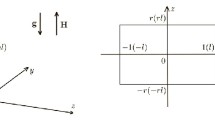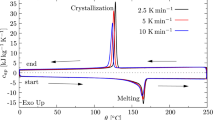Abstract
The molding processes of polymer melts involve geometrically complex dies. Such dies are usually tapered or streamlined to achieve a maximum output rate under conditions of laminar flow. The model of a generalized second-grade fluid of power-law type is used and the results obtained are illustrated by examples of convergent flows in conical and wedge-shaped dies.
Similar content being viewed by others
REFERENCES
P. Avenas, J. F. Agassant, and J. Ph. Sergent, La Mise en Forme des Matieres Plastiques, Tec-Doc. Lavoisier, Paris (1982).
D. M. Binding, “An approximate analysis for contraction and converging flows,” J. Non-Newt. Fluid Mech., 27, 173-189 (1988).
F. N. Cogswell, “Converging flow of polymer melts in extrusion dies,” Polym. Eng. Sci., 12, 64-73 (1972).
Z. P. Shulman, Convective Heat Transfer of Rheologically Complex Fluids [in Russian], Energy, Moscow (1975).
J. M. Eckmann, D. J. Wildman, and J. L. S. Chen, “Laminar flow studies of highly loaded suspensions in horizontal pipes,” Second Int. Symp. Slurry Flows, ASME FED, 38, 85-92 (1986).
E. Walicki and A. Walicka, “Basic flows of generalized second-grade fluids,” in: XIX Symp. on Rheology of RAS, 22-27 June. Coll. Abstracts, Klaipeda (1998), p. 78.
R. S. Rivlin and J. L. Ericksen, “Stress-deformation relations for isotropic materials,” J. Rat. Mech. Anal., 4, 323-435 (1955).
F. N. Cogswell, “Converging flow and stretching flow: a compilation,” J. Non-Newt. Fluid Mech., 4, 23-28 (1978).
E. Walicki and A. Walicka, “An approximate analysis for conical flow of viscoplastic fluids,” Reports, Fizyka-Chemia, T.U. Zielona Góra, 6-7, 197-217 (1994).
E. Walicki and A. Walicka, “Pressure drops in the conical flow of a molten metal,” in: Solid. Metals Alloys, Proc. Conf. “Foundry “95” (1995), 24, pp. 147-154.
E. Walicki, A. Walicka, and D. Michalski, “Analysis of a molten metal flow in the conical die,” in: Proc. of VIII Nat. Conf.: Tendencies in Manufacturing Processes, 16-18 Sept., Zielona Góra (1997), pp. 175-180.
E. Walicki, A. Walicka, and D. Michalski, “Pressure drops in the conical flow of a molten metal,” in: Proc. 5th European Rheology Conference, PortoroÞ (Slovenia), 6-11 Sept., PortoroÞ (1998), pp. 169-170.
E. Walicki, A. Walicka, D. Michalski, and P. Ratajczak, “Approximate analysis for conical flow of generalized second-grade fluids,” Les Cahiers de Rhéol., 15, 309-316 (1998).
E. Walicki and A. Walicka, “Convergent flows of generalized second-grade fluids of power-law type,” in: XX Symposium on Rheology of RAS, Karacharovo (Russia), 22-27 May. Coll. Abstracts (2000), pp. 203-204.
A. Walicka, “Flows of generalized second-grade fluids in rectilinear channels,” Appl. Mech. Eng., 4, No. 2, 375-395 (1999).
Author information
Authors and Affiliations
Rights and permissions
About this article
Cite this article
Walicki, E., Walicka, A. Convergent Flows of Molten Polymers Modeled by Generalized Second-Grade Fluids of Power-Law Type. Mechanics of Composite Materials 38, 89–94 (2002). https://doi.org/10.1023/A:1014017125466
Issue Date:
DOI: https://doi.org/10.1023/A:1014017125466




